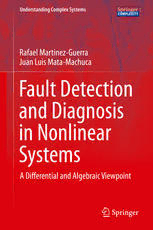Table Of ContentUnderstanding Complex Systems
Rafael Martinez-Guerra
Juan Luis Mata-Machuca
Fault Detection
and Diagnosis
in Nonlinear
Systems
A Diff erential and Algebraic Viewpoint
Springer Complexity
Springer Complexity is an interdisciplinary program publishing the best research and
academic-level teaching on both fundamental and applied aspects of complex systems –
cutting across all traditional disciplines of the natural and life sciences, engineering,
economics,medicine,neuroscience,socialandcomputerscience.
Complex Systems are systems that comprise many interacting parts with the ability to
generate anew qualityof macroscopic collectivebehavior themanifestations of whichare
the spontaneous formation of distinctive temporal, spatial or functional structures. Models
of such systems can be successfully mapped onto quite diverse “real-life” situations like
theclimate,thecoherentemissionoflightfromlasers,chemicalreaction-diffusionsystems,
biologicalcellularnetworks, thedynamicsofstockmarketsandoftheinternet,earthquake
statistics and prediction, freeway traffic, the human brain, or the formation of opinions in
socialsystems,tonamejustsomeofthepopularapplications.
Although their scope and methodologies overlap somewhat, one can distinguish the
following main concepts and tools: self-organization, nonlinear dynamics, synergetics,
turbulence,dynamicalsystems,catastrophes,instabilities,stochasticprocesses,chaos,graphs
and networks, cellular automata, adaptive systems, genetic algorithms and computational
intelligence.
ThethreemajorbookpublicationplatformsoftheSpringerComplexityprogramarethe
monograph series“Understanding ComplexSystems”focusing on thevariousapplications
of complexity, the “Springer Series in Synergetics”, which is devoted to the quantitative
theoreticalandmethodological foundations,andthe“SpringerBriefsinComplexity”which
are concise and topical working reports, case-studies, surveys, essays and lecture notes of
relevance to the field. In addition to the books in these two core series, the program also
incorporatesindividualtitlesrangingfromtextbookstomajorreferenceworks.
EditorialandProgrammeAdvisoryBoard
HenryAbarbanel,InstituteforNonlinearScience,UniversityofCalifornia,SanDiego,USA
DanBraha,NewEnglandComplexSystemsInstituteandUniversityofMassachusettsDartmouth,USA
Pe´ter E´rdi, Center for Complex Systems Studies, Kalamazoo College, USA and Hungarian Academy
ofSciences,Budapest,Hungary
KarlFriston,InstituteofCognitiveNeuroscience,UniversityCollegeLondon,London,UK
HermannHaken,CenterofSynergetics,UniversityofStuttgart,Stuttgart,Germany
ViktorJirsa,CentreNationaldelaRechercheScientifique(CNRS),Universite´delaMe´diterrane´e,Marseille,
France
JanuszKacprzyk,SystemResearch,PolishAcademyofSciences,Warsaw,Poland
KunihikoKaneko,ResearchCenterforComplexSystemsBiology,TheUniversityofTokyo,Tokyo,Japan
ScottKelso,CenterforComplexSystemsandBrainSciences,FloridaAtlanticUniversity,BocaRaton,USA
Markus Kirkilionis, Mathematics Institute and Centre for Complex Systems, University of Warwick,
Coventry,UK
Ju¨rgenKurths,NonlinearDynamicsGroup,UniversityofPotsdam,Potsdam,Germany
AndrzejNowak,DepartmentofPsychology,WarsawUniversity,Poland
LindaReichl,CenterforComplexQuantumSystems,UniversityofTexas,Austin,USA
PeterSchuster,TheoreticalChemistryandStructuralBiology,UniversityofVienna,Vienna,Austria
FrankSchweitzer,SystemDesign,ETHZurich,Zurich,Switzerland
DidierSornette,EntrepreneurialRisk,ETHZurich,Zurich,Switzerland
StefanThurner,SectionforScienceofComplexSystems,MedicalUniversityofVienna,Vienna,Austria
Understanding Complex Systems
FoundingEditor:S.Kelso
Future scientific and technological developments in many fields will necessarily
dependuponcomingtogripswithcomplexsystems.Suchsystemsarecomplexin
boththeircomposition–typicallymanydifferentkindsofcomponentsinteracting
simultaneouslyandnonlinearlywitheachotherandtheirenvironmentsonmultiple
levels–andintherichdiversityofbehaviorofwhichtheyarecapable.
TheSpringerSeriesinUnderstandingComplexSystemsseries(UCS)promotes
new strategies and paradigms for understanding and realizing applications of
complex systems research in a wide variety of fields and endeavors. UCS is
explicitlytransdisciplinary.Ithasthreemaingoals:First,toelaboratetheconcepts,
methodsandtoolsofcomplexsystemsatalllevelsofdescriptionandinallscientific
fields,especiallynewlyemergingareaswithinthelife,social,behavioral,economic,
neuro-andcognitivesciences(andderivativesthereof);second,toencouragenovel
applicationsoftheseideasinvariousfieldsofengineeringandcomputationsuchas
robotics,nano-technologyandinformatics;third,toprovidea singleforumwithin
whichcommonalitiesanddifferencesintheworkingsofcomplexsystemsmaybe
discerned,henceleadingtodeeperinsightandunderstanding.
UCS will publish monographs, lecture notes and selected edited contributions
aimedatcommunicatingnewfindingstoalargemultidisciplinaryaudience.
Forfurthervolumes:
http://www.springer.com/series/5394
Rafael Martinez-Guerra • Juan Luis Mata-Machuca
Fault Detection and Diagnosis
in Nonlinear Systems
A Differential and Algebraic Viewpoint
123
Rafael Martinez-Guerra Juan Luis Mata-Machuca
Departamento de Control Automatico Unidad Profesional Interdisciplinaria
CINVESTAV-IPN en Ingenieria y Tecnologias Avanzadas
Mexico, D.F. Instituto Politecnico Nacional
Mexico Academia de Mecatronica
Mexico, D.F.
Mexico
ISSN1860-0832 ISSN1860-0840(electronic)
ISBN978-3-319-03046-3 ISBN978-3-319-03047-0 (eBook)
DOI10.1007/978-3-319-03047-0
SpringerCham HeidelbergNewYorkDordrechtLondon
Library of Congress Control Number: 2013953239
(cid:2)c Springer International Publishing Switzerland 2014
Thisworkissubjecttocopyright.AllrightsarereservedbythePublisher,whetherthewholeorpartof
thematerialisconcerned,specificallytherightsoftranslation,reprinting,reuseofillustrations,recitation,
broadcasting,reproductiononmicrofilmsorinanyotherphysicalway,andtransmissionorinformation
storageandretrieval,electronicadaptation,computersoftware,orbysimilarordissimilarmethodology
nowknownorhereafterdeveloped.Exemptedfromthislegalreservationarebriefexcerptsinconnection
with reviews or scholarly analysis or material supplied specifically for the purpose of being entered
and executed on a computer system, for exclusive use by the purchaser of the work. Duplication of
this publication or parts thereof is permitted only under the provisions of the Copyright Law of the
Publisher’slocation,initscurrentversion,andpermissionforusemustalwaysbeobtainedfromSpringer.
PermissionsforusemaybeobtainedthroughRightsLinkattheCopyrightClearanceCenter.Violations
areliabletoprosecutionundertherespectiveCopyrightLaw.
Theuseofgeneraldescriptivenames,registerednames,trademarks,servicemarks,etc.inthispublication
doesnotimply,evenintheabsenceofaspecificstatement,thatsuchnamesareexemptfromtherelevant
protectivelawsandregulationsandthereforefreeforgeneraluse.
While the advice and information in this book are believed to be true and accurate at the date of
publication,neithertheauthorsnortheeditorsnorthepublishercanacceptanylegalresponsibilityfor
anyerrorsoromissionsthatmaybemade.Thepublishermakesnowarranty,expressorimplied,with
respecttothematerialcontainedherein.
Printedonacid-freepaper
SpringerispartofSpringerScience+BusinessMedia(www.springer.com)
Tomywifeandsons
Marilen,RafaelandJuanCarlos.
Tomyparentsandbrothers
Carlos,Virginia,Victor,Arturo,
Carlos,JavierandMarisela.
RafaelMart´ınez-Guerra
Tomystudents
JuanLuisMata-Machuca
Preface
Thisbookisaboutfaultsaspectsofdetectionanddiagnosisproblemsinnonlinear
systemswhicharerepresentedbyordinarydifferentialequationsfromadifferential
andalgebraicviewpoint.Thisframeworksoimportantforfaultdetectionanddiag-
nosis,isnotcommonlyfoundintextbooks.Aprominentroleisplayedbythetype
ofmathematicaltoolusedwhichisthemainingredienttothesolutionofsomereal
problems. The background material needed to understand this book is differential
algebraanddifferentialequations.Thisbookcanbeusedbystudentswithastrong
first year of algebra and differential equations, it is oriented mainly toward upper
divisionengineeringandsciencestudents.Itcanalsobeusedforagraduatecourse.
We have rather tried to unify the theory as much as possible with the practice by
focussing attention on a greatest number of techniques or procedures to tackle the
generalproblem.Ourgoalinthisbookistodeveloptechniquesusingauxiliarysys-
temsnamedalso“observers”tosolvethefaultdetectionanddiagnosisproblemin
nonlinearsystems.Thelevelofrigorishigh,andalmosteverythingisproved.We
havetriedtodevelopproofsthataddinsighttothetheoremsandthatareimportant
methods.Wehaveavoidedtheintroductionofsomeconceptsinordertomakethe
bookmorewidelyreadable,butthemainideascaneasilybeseeninthisbook.
Theplanofthebookisasfollows:
Infirsttwochapters,speciallychapters1and2,givearatherintensiveandcom-
plete study of the fault detection problem using residual generators by consider-
ingtwotypesoffaultswithapplicationtoanelectromechanicalpositioningsystem
and a Continuous Stirred Tank Reactor (CSTR). Chapters 3 and 4 are devoted to
faultdiagnosisproblem.Weintroducesomeconceptssuchasthe“differentialtran-
scendence degree” to attack this problem, as well as we introduce the concept of
“diagnosabilitycondition”basedonalgebricityofthefaultandweestablishsome
strongresultsontheminimalnumberofmeasurementswhichareprovedusingthe
differential transcendence degree with application to a bioreactor model and a hy-
draulic system. In chapter 5 is studied a fault detection method to detect the belt
breakdowninanexperimentalbeltdrivesystemusingaproportionalreducedorder
vii
viii Preface
observer.Inchapter6isdealtthefaultdiagnosisproblemusingtheleftinvertibility
condition,troughtheconceptofdifferentialoutputrank,themethodologyistested
inanexperimentalimplementationofathree-tanksystem.Inchapter7isboarded
defaultestimationproblemusingaslidingmodeobserverandthesocalledLinear
time-varying(LTV)differentiators.Inchapter8istackledthediagnosisproblemfor
non-differentiallyflatandLiouvilliansystemsbyusingtheconceptsofdifferential
transcendence degree and Hardy differential field. Finally, chapter 9 is devoted to
thediagnosisproblemusingapolynomialobservertobetestedintheexperimental
settingAmiraDTS200(three-tanksystem).
Me´xicoCity,Me´xico RafaelMart´ınez-Guerra
July2013 JuanLuisMata-Machuca
Contents
1 Thefaultdetectionprobleminnonlinearsystemsusingresidual
generators..................................................... 1
1.1 Introduction ............................................... 1
1.2 Observationproblem........................................ 2
1.3 Fundamentalproblemofresidualgeneration ................... 5
1.3.1 Residualgeneratorstability............................ 5
1.4 Faultdetection ............................................ 9
1.4.1 Constantfaultcase .................................. 9
1.4.2 Time-varyingfaultcase .............................. 13
1.5 Numericalexample......................................... 15
References..................................................... 19
2 FaultDetectioninCSTRUsingNonlinearObservers............... 21
2.1 Introduction ............................................... 21
2.2 Basicdefinitions ........................................... 22
2.3 Statementoftheproblem .................................... 23
2.3.1 Observersynthesis ................................... 24
2.4 ApplicationtoaCSTR ...................................... 24
2.5 Numericalresults........................................... 29
2.6 Concludingremarks ........................................ 29
References..................................................... 30
3 Diagnosisofnonlinearsystemsusingtheconceptofdifferential
transcendencedegree ........................................... 33
3.1 Introduction ............................................... 33
3.2 Statementoftheproblem .................................... 35
3.2.1 Onthediagnosabilitycondition ........................ 37
3.2.2 Ontheminimalnumberofmeasurements................ 38
3.2.3 Someproperties ..................................... 38
3.2.4 Examples........................................... 39
3.3 Reducedorderuncertaintyobserversynthesis ................... 40
ix

